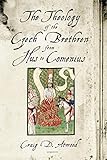The theology of the Czech Brethren from Hus to Comenius /Craig D. Atwood.
Material type: TextPublication details: University Park, Pennsylvania : Pennsylvania State University Press, (c)2009.Description: xix, 457 pages : illustrations ; 24 cmContent type:
TextPublication details: University Park, Pennsylvania : Pennsylvania State University Press, (c)2009.Description: xix, 457 pages : illustrations ; 24 cmContent type: - text
- unmediated
- volume
- 9780271035321
- BX4923 .T446 2009
- COPYRIGHT: covered - CIU has obtained rights for you to copy and share this title in electronic or print format with students, faculty, and staff.
| Item type | Current library | Collection | Call number | Status | Date due | Barcode | |
|---|---|---|---|---|---|---|---|
 Circulating Book (checkout times vary with patron status)
Circulating Book (checkout times vary with patron status)
|
G. Allen Fleece Library CIRCULATING COLLECTION | Non-fiction | BX4923.A896.T446 2009 (Browse shelf(Opens below)) | Available | 31923002098545 |
Includes bibliographies and index.
PART I: THE CZECH REFORMATION -- Prague and Oxford -- Hus -- The chalice -- Tabor -- The Brethren -- Chelcicky -- Gregory and the Unity -- Luke of Prague and the New Brethren -- Essentials, ministerials, and incidentals -- Brethren among the Protestants -- The Unity and the Lutherans -- The confession of 1535 -- Calvinists, humanists, and Brethren -- The labyrinth of the world -- Comenius's theology and pansophy -- The bequest of the Unity.
PART II: THE BRETHREN -- Chelcicky -- Gregory and the unity -- Luke of Prague and the New Brethren -- Essentials, ministerials, and incidentals --
PART III: BRETHREN AMONG THE PROTESTANTS -- The Unity and the Lutherans -- The confession of 1535 -- Calvinists, Humanists, and Brrethren -- The labyrinth of the world -- Comenius's theology and pansophy -- The bequest of the unity --
Craig Atwood addresses the serious lack of comprehensive treatments in English of the Moravians. The Moravian Church, or Unity of the Brethren, was the first Western church to make separation of church and state a matter of doctrine and policy. The Unity's vision for social and educational reform also sets it apart. Its theology centers on the key concepts of faith, love, and hope. The Unity-the heartbeat of the so-called Czech Reformation-was engaged with society and with other churches and did not retreat to isolationism, as did several movements in the Radical Reformation. Rather, the Unity continued to evolve as political and theological climates changed. AMAZON
COPYRIGHT: covered - CIU has obtained rights for you to copy and share this title in electronic or print format with students, faculty, and staff.
There are no comments on this title.
